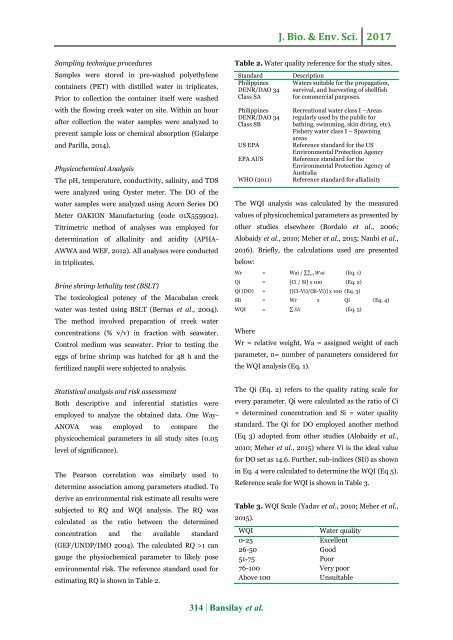Environmental risk assessment of Macabalan creek water in Cagayan de Oro, Philippines
Creek water carries both domestic and commercial wastewater consequently draining organic and inorganic pollutants to coastal water. The present study dealt on the environmental risk assessment of creek water stretching in Macabalan-Cagayan de Oro, Philippines. Selected physicochemical analyses of water samples were carried in both temporal and spatial variations. Risk quotient (RQ), water quality index (WQI), and brine shrimp lethality test (BSL) was employed to draw environmental risk estimate. Overall, dissolved oxygen (DO) concentrations were below the standard set regardless of temporal and spatial variations. Both RQ and WQI showed good statuses on creek water quality despite the low DO. The BSLT similarly indicated a higher concentration for LC50 to be established. The study was preliminary and further monitoring may be essential.
Creek water carries both domestic and commercial wastewater consequently draining organic and inorganic pollutants to coastal water. The present study dealt on the environmental risk assessment of creek water stretching in Macabalan-Cagayan de Oro, Philippines. Selected physicochemical analyses of water samples were carried in both temporal and spatial variations. Risk quotient (RQ), water quality index (WQI), and brine shrimp lethality test (BSL) was employed to draw environmental risk estimate. Overall, dissolved oxygen (DO) concentrations were below the standard set regardless of temporal and spatial variations. Both RQ and WQI showed good statuses on creek water quality despite the low DO. The BSLT similarly indicated a higher concentration for LC50 to be established. The study was preliminary and further monitoring may be essential.
You also want an ePaper? Increase the reach of your titles
YUMPU automatically turns print PDFs into web optimized ePapers that Google loves.
J. Bio. & Env. Sci. 2017<br />
Sampl<strong>in</strong>g technique procedures<br />
Samples were stored <strong>in</strong> pre-washed polyethylene<br />
conta<strong>in</strong>ers (PET) with distilled <strong>water</strong> <strong>in</strong> triplicates.<br />
Prior to collection the conta<strong>in</strong>er itself were washed<br />
with the flow<strong>in</strong>g <strong>creek</strong> <strong>water</strong> on site. With<strong>in</strong> an hour<br />
after collection the <strong>water</strong> samples were analyzed to<br />
prevent sample loss or chemical absorption (Galarpe<br />
and Parilla, 2014).<br />
Physicochemical Analysis<br />
The pH, temperature, conductivity, sal<strong>in</strong>ity, and TDS<br />
were analyzed us<strong>in</strong>g Oyster meter. The DO <strong>of</strong> the<br />
<strong>water</strong> samples were analyzed us<strong>in</strong>g Acorn Series DO<br />
Meter OAKION Manufactur<strong>in</strong>g (co<strong>de</strong> 01X555902).<br />
Titrimetric method <strong>of</strong> analyses was employed for<br />
<strong>de</strong>term<strong>in</strong>ation <strong>of</strong> alkal<strong>in</strong>ity and acidity (APHA-<br />
AWWA and WEF, 2012). All analyses were conducted<br />
<strong>in</strong> triplicates.<br />
Br<strong>in</strong>e shrimp lethality test (BSLT)<br />
The toxicological potency <strong>of</strong> the <strong>Macabalan</strong> <strong>creek</strong><br />
<strong>water</strong> was tested us<strong>in</strong>g BSLT (Bernas et al., 2004).<br />
The method <strong>in</strong>volved preparation <strong>of</strong> <strong>creek</strong> <strong>water</strong><br />
concentrations (% v/v) <strong>in</strong> fraction with sea<strong>water</strong>.<br />
Control medium was sea<strong>water</strong>. Prior to test<strong>in</strong>g the<br />
eggs <strong>of</strong> br<strong>in</strong>e shrimp was hatched for 48 h and the<br />
fertilized nauplii were subjected to analysis.<br />
Table 2. Water quality reference for the study sites.<br />
Standard<br />
Philipp<strong>in</strong>es<br />
DENR/DAO 34<br />
Class SA<br />
Philipp<strong>in</strong>es<br />
DENR/DAO 34<br />
Class SB<br />
US EPA<br />
EPA AUS<br />
WHO (2011)<br />
Description<br />
Waters suitable for the propagation,<br />
survival, and harvest<strong>in</strong>g <strong>of</strong> shellfish<br />
for commercial purposes.<br />
Recreational <strong>water</strong> class I –Areas<br />
regularly used by the public for<br />
bath<strong>in</strong>g, swimm<strong>in</strong>g, sk<strong>in</strong> div<strong>in</strong>g, etc).<br />
Fishery <strong>water</strong> class I – Spawn<strong>in</strong>g<br />
areas<br />
Reference standard for the US<br />
<strong>Environmental</strong> Protection Agency<br />
Reference standard for the<br />
<strong>Environmental</strong> Protection Agency <strong>of</strong><br />
Australia<br />
Reference standard for alkal<strong>in</strong>ity<br />
The WQI analysis was calculated by the measured<br />
values <strong>of</strong> physicochemical parameters as presented by<br />
other studies elsewhere (Bordalo et al., 2006;<br />
Alobaidy et al., 2010; Meher et al., 2015; Naubi et al.,<br />
2016). Briefly, the calculations used are presented<br />
below:<br />
Wr = Wai / ∑n<br />
i=1 Wai (Eq. 1)<br />
Qi = [Ci / Si] x 100 (Eq. 2)<br />
Qi (DO) = [(Ci-Vi)/(Si-Vi)] x 100 (Eq. 3)<br />
SIi = Wr x Qi (Eq. 4)<br />
WQI = ∑ SIi (Eq. 5)<br />
Where<br />
Wr = relative weight, Wa = assigned weight <strong>of</strong> each<br />
parameter, n= number <strong>of</strong> parameters consi<strong>de</strong>red for<br />
the WQI analysis (Eq. 1).<br />
Statistical analysis and <strong>risk</strong> <strong>assessment</strong><br />
Both <strong>de</strong>scriptive and <strong>in</strong>ferential statistics were<br />
employed to analyze the obta<strong>in</strong>ed data. One Way-<br />
ANOVA was employed to compare the<br />
physicochemical parameters <strong>in</strong> all study sites (0.05<br />
level <strong>of</strong> significance).<br />
The Pearson correlation was similarly used to<br />
<strong>de</strong>term<strong>in</strong>e association among parameters studied. To<br />
<strong>de</strong>rive an environmental <strong>risk</strong> estimate all results were<br />
subjected to RQ and WQI analysis. The RQ was<br />
calculated as the ratio between the <strong>de</strong>term<strong>in</strong>ed<br />
concentration and the available standard<br />
(GEF/UNDP/IMO 2004). The calculated RQ >1 can<br />
gauge the physiochemical parameter to likely pose<br />
environmental <strong>risk</strong>. The reference standard used for<br />
estimat<strong>in</strong>g RQ is shown <strong>in</strong> Table 2.<br />
The Qi (Eq. 2) refers to the quality rat<strong>in</strong>g scale for<br />
every parameter. Qi were calculated as the ratio <strong>of</strong> Ci<br />
= <strong>de</strong>term<strong>in</strong>ed concentration and Si = <strong>water</strong> quality<br />
standard. The Qi for DO employed another method<br />
(Eq 3) adopted from other studies (Alobaidy et al.,<br />
2010; Meher et al., 2015) where Vi is the i<strong>de</strong>al value<br />
for DO set as 14.6. Further, sub-<strong>in</strong>dices (SIi) as shown<br />
<strong>in</strong> Eq. 4 were calculated to <strong>de</strong>term<strong>in</strong>e the WQI (Eq 5).<br />
Reference scale for WQI is shown <strong>in</strong> Table 3.<br />
Table 3. WQI Scale (Yadav et al., 2010; Meher et al.,<br />
2015).<br />
WQI<br />
Water quality<br />
0-25 Excellent<br />
26-50 Good<br />
51-75 Poor<br />
76-100 Very poor<br />
Above 100<br />
Unsuitable<br />
314 | Bansilay et al.


















